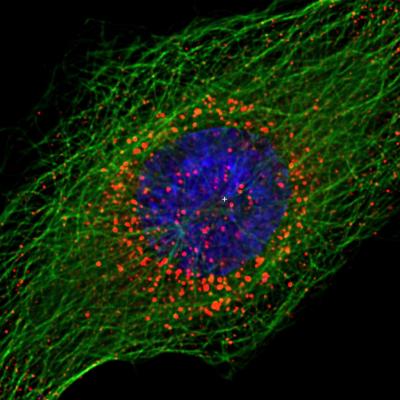Loyola study reveals how HIV enters cell nucleus

IV-1 viral cores (red) accumulate around the cell nucleus (blue) but remain unable to enter following depletion of the motor protein KIF5B. Credit: Loyola University Chicago
The discovery, reported in the journal PLOS Pathogens, could lead to effective new drugs to treat HIV/AIDS, said Edward M. Campbell, PhD, corresponding author of the study. Campbell is an associate professor in the Department of Microbiology and Immunology of Loyola University Chicago Stritch School of Medicine.
HIV infects and kills immune system cells, including T cells and macrophages. This cripples the immune system, making the patient vulnerable to common bacteria, viruses and other pathogens that usually don't cause problems in people with healthy immune systems.
Once HIV enters a cell, it has to find a way to get inside the nucleus, the compartment that contains the cell's DNA. Many related viruses do this by waiting until the cell divides, when the protective membrane surrounding the nucleus breaks down. But HIV has the insidious ability to enter the nucleus in a non-dividing cell with an intact nuclear membrane. (This membrane also is known as the nuclear envelope.)
How HIV gets through the nuclear envelope has been a mystery. In part, this is because the HIV core (the protein shell that protects the HIV genome) is 50 percent larger than the pores in the envelope. These pores normally enable cellular proteins and other materials to go back and forth between the nucleus and the rest of the cell.
Campbell and colleagues discovered that a motor protein, called KIF5B, interacts with both the HIV-1 core and the nuclear pore in a way that allows HIV into the nucleus. Normally KIF5B transports various cargoes within the cell, away from the nucleus. But HIV hijacks KIF5B to serve a different purpose: It induces KIF5B to tear off pieces of the nuclear envelope and transport them away from the nucleus, thus making the pore wide enough for HIV to pass through. (The pieces that are torn off are proteins called Nup358.)
The discovery opens a potential new strategy for fighting HIV. Developing a drug that prevents KIF5B from disrupting nuclear pores would prevent HIV from sneaking into the nucleus without detection. This would give the immune system enough time to sound the alarm to attack and destroy HIV.
Cells have surveillance mechanisms to detect viruses, and their DNA, in the cytoplasm (the part of the cell outside the nucleus). But HIV typically can enter the nucleus before it is detected by these mechanisms. Trapping HIV in the cytoplasm would not only prevent an infection, it might also lead to HIV being detected and thus prompt an immune response.
“It's like making a bank vault harder to break into,” Campbell said. “In addition to making the money more secure, it would increase the chance of sounding the alarm and catching the burglars.”
###
The study was supported by a grant from the National Institute of Allergy and Infectious Diseases. It's titled “KIF5B and Nup358 cooperatively mediate the nuclear import of HIV-1 during infection.”
In addition to Campbell, co-authors are Adarsh Dharan, PhD, (first author); Sarah Talley, MS; Abhishek Tripathi, PhD; and Matthias Majetshak, PhD; all of Loyola's Stritch School of Medicine; and Thomas J. Hope, PhD and João Mamede, PhD of Northwestern University Feinberg School of Medicine.
Media Contact
All latest news from the category: Health and Medicine
This subject area encompasses research and studies in the field of human medicine.
Among the wide-ranging list of topics covered here are anesthesiology, anatomy, surgery, human genetics, hygiene and environmental medicine, internal medicine, neurology, pharmacology, physiology, urology and dental medicine.
Newest articles

NASA: Mystery of life’s handedness deepens
The mystery of why life uses molecules with specific orientations has deepened with a NASA-funded discovery that RNA — a key molecule thought to have potentially held the instructions for…

What are the effects of historic lithium mining on water quality?
Study reveals low levels of common contaminants but high levels of other elements in waters associated with an abandoned lithium mine. Lithium ore and mining waste from a historic lithium…

Quantum-inspired design boosts efficiency of heat-to-electricity conversion
Rice engineers take unconventional route to improving thermophotovoltaic systems. Researchers at Rice University have found a new way to improve a key element of thermophotovoltaic (TPV) systems, which convert heat…



